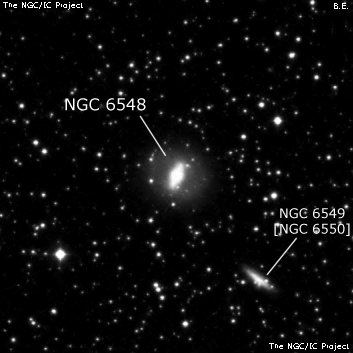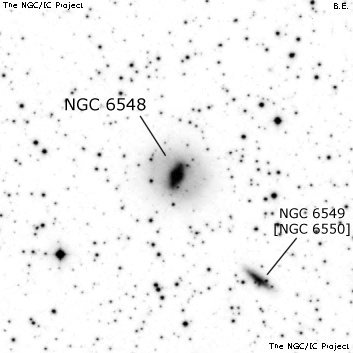NGC/IC Project Restoration Effort
(This is a very very beta version)
NGC6548


Basic Information
Location and Magnitude
Right Ascension: 18:5:59.2
Declination: +18:35:14
Constellation: HER
Visual Magnitude: 11.7
Historic Information
Discoverer: Herschel W.
Year of discovery: 1786
Discovery aperture: 18.7
Observational
Summary description: cF, S, lE, r
Sub-type: SB0
Corwin's Notes
=====
NGC 6548 and NGC 6550 = NGC 6549. There are two galaxies in this field; the
brighter, NGC 6548, was found by WH in June of 1786, and given the number III
555 in his catalogue of nebulae and clusters. WH's position reduces to
18 03 55, +18 33.5 (B1950.0), about 2.2 arcmin southeast of the modern
position for the brighter object. The position in GC and NGC was either
reduced with respect to a rather crude position for the comparison star (101
Her), or a (simple digit?) error of -20 seconds of time has crept into the RA.
The fainter galaxy was first seen by Marth in July 1864, and was rediscovered
18 years later by Stephan. Both noted the brighter object. Marth simply says
"... near III 555" in his description, while Stephan says "Distinct from [GC]
4377 and [GC] 5892." Dreyer condensed that for the NGC by adding "... near
m361" to Stephan's description. Since there are only the two nebulae here,
and because Stephan did not measure the brighter objects he claims to have
seen, we can only speculate on what his third object must have been. Perhaps
it is the line of three stars east of Marth's galaxy.
In any event, it is clear that Stephan and Marth found the same galaxy.
Stephan's accurately measured position precesses to 18 03 38.4, +18 31 48,
while Marth's less accurately estimated position precesses to 18 03 36,
+18 32.2, still quite close to the galaxy.
There matters would have stood had Lewis Swift not published a cryptic note in
his 11th list of nebulae (AN 147, 210, 1898): "NGC 6550 = H III 555. 6550
must be struck out." The wording of Swift's original note in his "Catalogue
No. II ..." (which appeared in PASP 9, 186, 1897, and in MNRAS 57, 629, 1897)
makes better sense: "NGC 6550 must be struck out, as it is identical with
H. III 555." Dreyer made what sense he could of all this, and has a Note in
the second IC which reads "6548 = 6550, Swift in Cat. XI." (Dreyer also
changed the NGC number to "6550" for H III 555 in his 1912 collection of WH's
papers.) Swift was apparently trying to tell us that there are only two
galaxies here, too, but his wording in the AN list just made the cataloguing
problem worse.
Enough people have read the IC Note that the modern identifications are
thoroughly confused. An obvious predilection for the objects in RA order has
also fed the confusion. In the end, though, it is clear that WH found the
brighter, northeastern galaxy, while Marth saw both objects -- and Stephan not
only saw the two real galaxies, but (apparently) an asterism as well.
So, my position table reflects this by keeping Dreyer's original NGC number,
6548, on H III 555; and by equating Marth's and Stephan's "novae", N6549 and
N6550.
N6549, by the way, has several stars superposed and is, itself, superposed on
a much fainter galaxy. I've attempted to give the positions of the NGC object
as well as the background galaxy.
Steve's Notes
=====
NGC 6548
17.5" (7/1/89): moderately bright, fairly small, elongated NNW-SSE, sharp concentration with a very bright core dominating a faint halo. Forms a pair with NGC 6549 3.7' SW.



